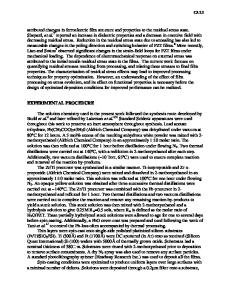Residual Stress in Silicon Nitride Thin Films Deposited by ECR-PECVD
- PDF / 335,351 Bytes
- 6 Pages / 612 x 792 pts (letter) Page_size
- 84 Downloads / 310 Views
U11.4.1
Residual Stress in Silicon Nitride Thin Films Deposited by ECR-PECVD E. Cianci and V. Foglietti Istituto di Fotonica e Nanotecnologie (IFN), CNR, Via Cineto Romano 42, 00156 Roma, Italy ABSTRACT We have investigated the influence of process parameters in electron cyclotron resonance plasma enhanced chemical vapour deposition (ECR-PECVD) of silicon nitride, on the intrinsic stress of thin SiN films and on their composition, in order to obtain SiNx films suitable to micromechanical applications. The silane to nitrogen gas flow ratio, along with addition of helium to gas mixture, was found to be a critical parameter for the tuning of the intrinsic stress in ECR-PECVD SiNx films, from compressive to tensile stress, with a maximum related to the largest Si-N bond density in the film.
INTRODUCTION Silicon nitride has gained increasing interest in the field of microsystem technology, due to its mechanical properties suitable for the fabrication of thin suspended structures as membranes and cantilevers in micromechanical sensors and actuators, including pressure sensors, condenser microphones, accelerometers and optical mirrors [1]. Processes that employ electron cyclotron resonance plasma-enhanced chemical deposition (ECR-PECVD) technique for deposition of silicon nitride have been developed to obtain high quality material to be used in a large range of applications in microelectronics and optoelectronics, as ion implantation masks, as passivation layers to protect devices against contamination, as insulating films and optical coatings [2]. An ECR source can produce a plasma with high degree of ionization, high densities of ions, radicals and excited particles also at low pressure (mTorr) with low ion energy allowing the growth of SiN films with low hydrogen content at low temperature, using nitrogen as reactant gas. In fact, despite of its high stability, N2 can be dissociated in atomic N in ECR plasma, and can react with silane to form silicon nitride, without high hydrogen incorporation that deteriorates film properties and high thermal budget that forbids the use of a wide range of materials sensitive to temperature as plastic substrates. ECR occurs in a plasma under appropriate magnetic and electric field conditions. With a combination of microwaves at 2.45 GHz and a 875-Gauss magnetic field, due to the use of standardized microwave supplies, free electrons in the plasma are forced to move along spyral paths synchronised with the microwaves along the magnetic field lines and in this way absorb energy resonantly from the exciting electric field. The energy so gained by the electrons is transferred by collisions to neutral gas molecules producing a high ion-density plasma [3]. In the present study we have investigated the influence of process parameters in ECR PECVD in order to find SiN films with optimal mechanical properties for micromechanical sensors. We have mainly studied the effect of silane to nitrogen flow rates ratio on the intrinsic stress of thin SiN films. The presence of a large compressive stres
Data Loading...




